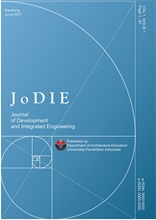THE EFFECTIVENESS OF USE OF DIFABLE RESIDENTIAL UNITS ON THE DESIGN OF A PROTOTYPE OF STUDENT FLATS FROM PUPR
Abstract
Several universities in Indonesia have received assistance for the construction of student flats since the issuance of the policy on assistance for the construction of flats for higher education institutions. One of them is in the city of Bandung on the STAIPI Campus (Persistent Indonesian Islamic School of Religion) Bandung, Kec. Bojongsoang, Bandung City. This university received donations for a 1-tower student flat building with a prototype design. In this observation, we will discuss the effectiveness of the use of special housing units for the disabled in student flats, and that these disabled residential facilities are used properly according to their designation. The research methodology used is qualitative, and the research method used is a literature review method. In the 1 year, the student flats facilities, especially the disabled housing units, and several applications of inclusive designs have not been effective. For example, the disabled housing unit is temporarily filled by other students. The conclusion from the effectiveness of the use of special housing for the disabled is still not effective, because this student Rusunawa facility has only been operating for 1 year from the 2020 Academic Year to the 2021 Academic Year.
Keywords: Student Flats, Disabled Residential Units, Prototype
Full Text:
PDFReferences
Alhamdani, M. R., & Sari, D. P. (2019). Performance Evaluation of Pontianak Kapuas Indah Market from Architecture and Behaviour Aspect. Journal of Architectural Research and Education, 1(2), 107.
Anissa, I. N., Saladin, A., & Rahmah, N. (2020). Konsep Integrasi Stasiun Lrt Bekasi Timur Dengan Kawasan Mixed-Use Lrt City Bekasi Timur. Jurnal Arsitektur ZONASI, 3(3), 291–298.
Anggita, M., Linggasani, W., Haristianti, V., & Sabatini, S. N. (2020). THE CORRELATION BETWEEN THE OPEN SPACE EXISTENCE AND BUILDING HEIGHT ON JAKARTA ’ S ROADS. Journal of Architectural Researh and Education, 2(1), 1–9. https://doi.org/10.17509/jare.v2i1.24116
Azza, S., & Natalia, D. A. R. (2019). Penerapan Konsep Healing Architecture. Jurnal Arsitektur ZONASI, 2(3), 210–219.
Bagus, G., Wicaksana, A., Agung, A., & Aritama, N. (2020). Future City Based on Smart Mobility Concept : Character and Benchmarking. Journal of Architectural Researh and Education, 2(1), 10–18.
Haryanti, RH (2017). Tourism Accessibility for People with Disabilities in Surakarta (Evaluation Study of Minister of Public Works Regulation Number 30 of 2006 concerning Technical Guidelines for Facilities and Accessibility in Buildings and the Environment). Public Spirit: Journal of Public Administration, Vol.12, No, 85–96.
Hejazi, S. (2020). The Gap between Architecture Education and Architectural Profession in Iran. Journal of Architectural Research and Education, 2(2), 121–133. https://doi.org/10.17509/jare.v2i2.28026
Heliandry, LD (2020). Learning During the Covid-19 Pandemic. Journal of Educational Technology, Vol.22, 65–70.
Jajuli, A., & Munawaroh, A. S. (2020). KENYAMANAN SIRKULASI ASRAMA MAHASISWA UNIVERSITAS NEGERI LAMPUNG ( UNILA ) BERDASARKAN PERSEPSI PENGHUNI. Jurnal Arsitektur Zonasi, 3(2), 136–143.
Kartika, SG (2018). The Application of Inclusive Design in the Design of Inclusive Early Childhood Education Studios in Yogyakarta. Senthong Scientific Journal, Vol.1, 1–9.
Kencanasari, R. . V., Surahman, U., Permana, A. Y., & Nugraha, H. D. (2020). Enhancing Community Environmental Awareness Through Indoor Air Quality Workshop. Journal of Architectural Research and Education, 2(2), 165–175. https://doi.org/10.17509/jare.v2i2.30290
Latifah, S. (2017). Accessibility for Disabled in Hotel Buildings in Surakarta City. Journal of Disability Studies, Vol. 04 Nos, 129–136.
Lustiyati, ED (2019). Accessibility of Sanitation Facilities for Diffables in Public Transportation Places. Journal of Disability Studies, Vol.6, 95–125.
Muflihah, A. N., Ayu, D., & Natalia, R. (2020). KAWASAN WISATA WATERFRONT TANJUNG ADIKARTO. Jurnal Arsitektur ZONASI, 3(1), 76–88. https://doi.org/doi.org/10.17509/jaz.v3i1.17892
Permana, A. Y., & Wijaya, K. (2017). Spatial change transformation of educational areas in Bandung. IOP Conference Series: Earth and Environmental Science, 99, 012029. https://doi.org/10.1088/1755-1315/99/1/012029
Prihutama, M. (2020). Kajian konsep arsitektur metafora pada bangunan bertingkat tinggi. Jurnal Arsitektur Zonasi, 3(2).
Primadella, & Ikaputra. (2019). Waterfront culture sebagai atraksi wisata tepian air. Jurnal Arsitektur ZONASI, 2(2), 88–97.
Putri, N. P. R. P. A., & Widiantara, I. P. A. (2019). Strategi Konservasi Guna Mempertahankan Identitas Arsitektur Pura Situs di Desa Sibang (Pengurangan Resiko Sosial, Ekonomi, dan Arsitektural). Jurnal Arsitektur ZONASI, 2(1), 68. https://doi.org/10.17509/jaz.v2i1.15063
Radissa, VS (2020). Overview of Accessibility Conditions of Public Building Facilities for People with Physical Disabilities Users of Wheelchairs in Various Countries. Proceedings of Research and Community Service, Vol.7, 406–413.
Rizki, M., Tri, T., Prayogi, L., & Jakarta, U. M. (2020). KAJIAN ARSITEKTUR MODERN PADA PRASARANA SEKOLAH KEBERBAKATAN OLAHRAGA ( SKO ). Jurnal Arsitektur Zonasi, 3(2), 252–260.
Rizky, UF (2014). Identifying the Needs of Students with Disabilities after High School. Indonesian Journal of Disability Studies, 52–59.
Suprapto, RA (2020). The Urgency of Disabled-Friendly Toilets in Homes for People with Disabilities. SEMINAR PROCEDURE, 324–328.
Vidiyanti, C., Siswanto, R., & Ramadhan, F. (2020). Pengaruh bukaan terhadap pencahayaan alami dan penghawaan alami pada masjid al ahdhar bekasi. Jurnal Arsitektur Zonasi, 3(1), 20–33.
Wahyudi, LT (2020). Analysis of Accessibility and Facilities for Disabilities at Masjid At-Taqwa Bandung. Science and Engineering National Seminar 5 (SENS 5), 396–410.
Wicaksono, D. (2020). Study of Ramp Accessibility Elements (For Persons with Disabilities) at Public Facilities, Faculty of Engineering, UNNES. Indonesian Journal of Conservation, 106–118.
DOI: https://doi.org/10.17509/jodie.v2i1.43895
Refbacks
Copyright (c) 2023 Putri Yastine Nurlestya

This work is licensed under a Creative Commons Attribution-NonCommercial-ShareAlike 4.0 International License.

This work is licensed under a Creative Commons Attribution-ShareAlike 4.0 International License.








